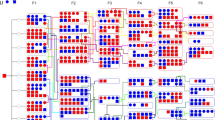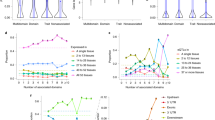Abstract
Understanding the genetics of behavioral variation remains a fascinating but difficult problem with considerable theoretical and practical implications. We used the genome-tagged mice (GTM) and an extensive test battery of well-validated behavioral assays to scan the genome for behavioral quantitative trait loci (QTLs). The GTM are a panel of ‘speed congenic’ mice consisting of over 60 strains spanning the entire autosomal genome. Each strain harbors a small (∼23 cM) DBA/2J donor segment on a uniform C57BL/6J background. The panel allows for mapping to regions as small as 5 cM and provides a powerful new tool for increasing mapping power and replicability in the analysis of QTLs. A total of 97 loci were mapped for a variety of complex behavioral traits including hyperactivity, anxiety, prepulse inhibition, avoidance and conditional fear. A larger number of loci were recovered than generally attained from standard mapping crosses. In addition, a surprisingly high proportion of loci, 63%, showed phenotypes unlike either of the parental strains. These data suggest that epistasis decreases sensitivity of locus detection in traditional crosses and demonstrate the utility of the GTM for mapping complex behavioral traits with high sensitivity and precision.
This is a preview of subscription content, access via your institution
Access options
Subscribe to this journal
Receive 12 print issues and online access
$259.00 per year
only $21.58 per issue
Buy this article
- Purchase on Springer Link
- Instant access to full article PDF
Prices may be subject to local taxes which are calculated during checkout





Similar content being viewed by others
References
Caldarone B, Saavedra C, Tartaglia K, Wehner JM, Dudek BC, Flaherty L . Quantitative trait loci analysis affecting contextual conditioning in mice. Nat Genet 1997; 17: 335–337.
Wehner JM, Radcliffe RA, Rosmann ST, Christensen SC, Rasmussen DL, Fulker DW et al. Quantitative trait locus analysis of contextual fear conditioning in mice. Nat Genet 1997; 17: 331–334.
Flint J, Corley R, DeFries JC, Fulker DW, Gray JA, Miller S et al. A simple genetic basis for a complex psychological trait in laboratory mice. Science 1995; 269: 1432–1435.
Gershenfeld HK, Neumann PE, Mathis C, Crawley JN, Li X, Paul SM . Mapping quantitative trait loci for open-field behavior in mice. Behav Genet 1997; 27: 201–210.
Gershenfeld HK, Paul SM . Mapping quantitative trait loci for fear-like behaviors in mice. Genomics 1997; 46: 1–8.
Talbot CJ, Nicod A, Cherny SS, Fulker DW, Collins AC, Flint J . High-resolution mapping of quantitative trait loci in outbred mice. Nat Genet 1999; 21: 305–308.
Geyer MA, McIlwain KL, Paylor R . Mouse genetic models for prepulse inhibition: an early review. Mol Psychiatry 2002; 7: 1039–1053.
Yalcin B, Willis-Owen SA, Fullerton J, Meesaq A, Deacon RM, Rawlins JN et al. Genetic dissection of a behavioral quantitative trait locus shows that Rgs2 modulates anxiety in mice. Nat Genet 2005; 36: 1197–1202.
Yoshikawa T, Watanabe A, Ishitsuka Y, Nakaya A, Nakatani N . Identification of multiple genetic loci linked to the propensity for ‘behavioral despair’ in mice. Genome Res 2002; 12: 357–366.
Flint J . The genetic basis of cognition. Brain 1999; 122: 2015–2032.
Wehner JM, Radcliffe RA, Bowers BJ . Quantitative genetics and mouse behavior. Annu Rev Neurosci 2001; 24: 845–867.
Wahlsten D, Rustay NR, Metten P, Crabbe JC . In search of a better mouse test. Trends Neurosci 2003; 26: 132–136.
Wahlsten D, Metten P, Phillips TJ, Boehm II SL, Burkhart-Kasch S, Dorow J et al. Different data from different labs: lessons from studies of gene–environment interaction. J Neurobiol 2003; 54: 283–311.
Kafkafi N, Benjamini Y, Sakov A, Elmer GI, Golani I . Genotype–environment interactions in mouse behavior: a way out of the problem. Proc Natl Acad Sci 2005; 102: 4619–4624.
Iakoubova OA, Olsson CL, Dains KM, Ross DA, Andalibi A, Lau K et al. Genome-tagged mice (GTM): two sets of genome-wide congenic strains. Genomics 2001; 74: 89–104.
Sayah DM, Khan AH, Gasperoni TL, Smith DJ . A genetic screen for novel behavioral mutations in mice. Mol Psychiatry 2001; 5: 369–377.
Kazlauckas V, Schuh J, Dall’Igna OP, Pereira GS, Bonan CD, Lara DR . Behavioral and cognitive profile of mice with high and low exploratory phenotypes. Behav Brain Res 2005; 162: 272–278.
Pellow S, Chopin P, File SE, Briley M . Validation of open, closed arm entries in an elevated plus-maze as a measure of anxiety in the rat. J Neurosci Methods 1985; 14: 149–167.
Rodgers RJ, Dalvi A . Anxiety, defence and the elevated plus-maze. Neurosci Biobehav Rev 1997; 21: 801–810.
Kim JJ, Rison RA, Fanselow MS . Effects of amygdala, hippocampus, and periaqueductal gray lesions on short- and long-term contextual fear. Behav Neurosci 1993; 107: 1093–1098.
Anagnostaras SG, Josselyn SA, Frankland PW, Silva AJ . Computer-assisted behavioral assessment of Pavlovian fear conditioning in mice. Learn Mem 2001; 7: 58–72.
O’Reilly RC, Rudy JW . Conjunctive representations in learning and memory: principles of cortical and hippocampal function. Psychol Rev 2001; 108: 311–345.
Santini E, Ge H, Ren K, Pena de Ortiz S, Quirk GJ . Consolidation of fear extinction requires protein synthesis in the medial prefrontal cortex. J Neurosci 2004; 24: 5704–5710.
Phillips RG, LeDoux JE . Differential contribution of amygdala and hippocampus to cued and contextual fear conditioning. Behav Neurosci 1992; 106: 274–285.
Maren S, Aharonov G, Fanselow MS . Neurotoxic lesions of the dorsal hippocampus and Pavlovian fear conditioning in rats. Behav Brain Res 1997; 88: 261–274.
Milad MR, Quirk GJ . Neurons in medial prefrontal cortex signal memory for fear extinction. Nature 2002; 420: 70–74.
Fanselow MS . Contextual fear, gestalt memories, and the hippocampus. Behav Brain Res 2000; 110: 73–81.
Paylor R, Crawley JN . Inbred strain differences in prepulse inhibition of the mouse startle response. Psychopharmacology 1997; 132: 169–180.
Porsolt RD, Bertin A, Jalfre M . Behavioral despair in mice: a primary screening test for antidepressants. Arch Int Pharmacodyn Ther 1977a; 229: 327–336.
Porsolt RD, Le Pichon M, Jalfre M . Depression: a new animal model sensitive to antidepressant treatments. Nature 1977b; 266: 730–732.
Liu D, Singh RP, Khan AH, Bhavsar K, Lusis AJ, Davis RC et al. Identifying loci for behavioral traits using genome-tagged mice. J Neurosci Res 2003; 74: 562–569.
Liu D, Singh RP, Khan AH, Lusis AJ, Davis RC, Smith DJ . Mapping behavioral traits by use of genome-tagged mice. Am J Geriatr Psychiatry 2004; 12: 158–165.
Grillon C, Ameli R, Charney DS, Krystal J, Braff D . Startle gating deficits occur across prepulse intensities in schizophrenic patients. Biol Psychiatry 1992; 32: 939–943.
Waldo M, Myles-Worsley M, Madison A, Byerley W, Freedman R . Sensory gating deficits in parents of schizophrenics. Am J Med Genet 1995; 60: 506–511.
Xu Y, Demarest K, Hitzemann R, Sikela JM . Gene coding variant in Cas1 between the C57BL/6J and DBA/2J inbred mouse strains: linkage to a QTL for ethanol-induced locomotor activation. Alcohol Clin Exp Res 2002; 26: 1–7.
Kempermann G, Gage FH . Genetic determinants of adult hippocampal neurogenesis correlate with acquisition, but not probe trial performance, in the water maze task. Eur J Neurosci 2002; 16: 129–136.
Singer JB, Hill AE, Nadeau JH, Lander ES . Mapping quantitative trait loci for anxiety in chromosome substitution strains of mice. Genetics 2005; 169: 855–862.
Wang J, Williams RW, Manly KF . WebQTL: web-based complex trait analysis. Neuroinformatics 2003; 1: 299–308.
Valentinuzzi VS, Kolker DE, Vitaterna MH, Shimomura K, Whiteley A, Low-Zeddies S et al. Automated measurement of mouse freezing behavior and its use for quantitative trait locus analysis of contextual fear conditioning in (BALB/cJ × C57BL/6J) F2 mice. Learn Mem 1998; 5: 391–403.
Willis-Owen SA, Flint J . Identifying the genetic determinants of emotionality in humans: insights from rodents. Neurosci Biobehav Rev 2006; 31: 115–124.
Anagnostaras SG, Gale GD, Fanselow MS . Hippocampus and contextual fear conditioning: recent controversies and advances. Hippocampus 2001; 11: 8–17.
Gorman JM, Kent JM, Sullivan GM, Coplan JD . Neuroanatomical hypothesis of panic disorder, revised. Am J Psychiatry 2000; 157: 493–505.
Marshall RD, Garakani A . Psychobiology of the acute stress response and its relationship to the psychobiology of post-traumatic stress disorder. Psychiatr Clin N Am 2002; 25: 385–395.
Bouton ME, Nelson JB, Rosas JM . Stimulus generalization, context change, and forgetting. Psychol Bull 1999; 125: 171–186.
Henderson ND, Turri MG, DeFries JC, Flint J . QTL analysis of multiple behavioral measures of anxiety in mice. Behav Genet 2004; 34: 267–293.
Schafe GE, LeDoux JE . Memory consolidation of auditory Pavlovian fear conditioning requires protein synthesis and protein kinase A in the amygdala. J Neurosci 2000; 20: RC96.
Josselyn SA, Shi C, Carlezon Jr WA, Neve RL, Nestler EJ, Davis M . Long-term memory is facilitated by cAMP response element-binding protein overexpression in the amygdala. J Neurosci 2001; 21: 2404–2412.
Romanski LM, LeDoux JE . Equipotentiality of thalamo–amygdala and thalamo–cortico–amygdala circuits in auditory fear conditioning. J Neurosci 1992; 12: 4501–4509.
Waddell J, Dunnett C, Falls WA . C57BL/6J and DBA/2J mice differ in extinction and renewal of extinguished conditioned fear. Behav Brain Res 2004; 154: 567–576.
Valdar W, Solberg LC, Gauguier D, Burnett S, Klenerman P, Cookson WO et al. Genome-wide genetic association of complex traits in heterogeneous stock mice. Nat Genet 2006; 38: 879–8870.
Iakoubova OA, Olsson CL, Dains KM, Ross DA, Andalibi A, Lau K et al. Genome-tagged mice (GTM): two sets of genome-wide congenic strains. Genetics 2001; 74: 89–104.
Acknowledgements
We acknowledge funding from the National Institutes of Health RO1 MH071779.
Author information
Authors and Affiliations
Corresponding author
Rights and permissions
About this article
Cite this article
Gale, G., Yazdi, R., Khan, A. et al. A genome-wide panel of congenic mice reveals widespread epistasis of behavior quantitative trait loci. Mol Psychiatry 14, 631–645 (2009). https://doi.org/10.1038/mp.2008.4
Received:
Revised:
Accepted:
Published:
Issue Date:
DOI: https://doi.org/10.1038/mp.2008.4
Keywords
This article is cited by
-
Reductions in synaptic proteins and selective alteration of prepulse inhibition in male C57BL/6 mice after postnatal administration of a VIP receptor (VIPR2) agonist
Psychopharmacology (2015)
-
Epistasis and quantitative traits: using model organisms to study gene–gene interactions
Nature Reviews Genetics (2014)
-
Genetic variability in the rat Aplec C-type lectin gene cluster regulates lymphocyte trafficking and motor neuron survival after traumatic nerve root injury
Journal of Neuroinflammation (2013)
-
Gene networks associated with conditional fear in mice identified using a systems genetics approach
BMC Systems Biology (2011)
-
Mouse genomic variation and its effect on phenotypes and gene regulation
Nature (2011)



